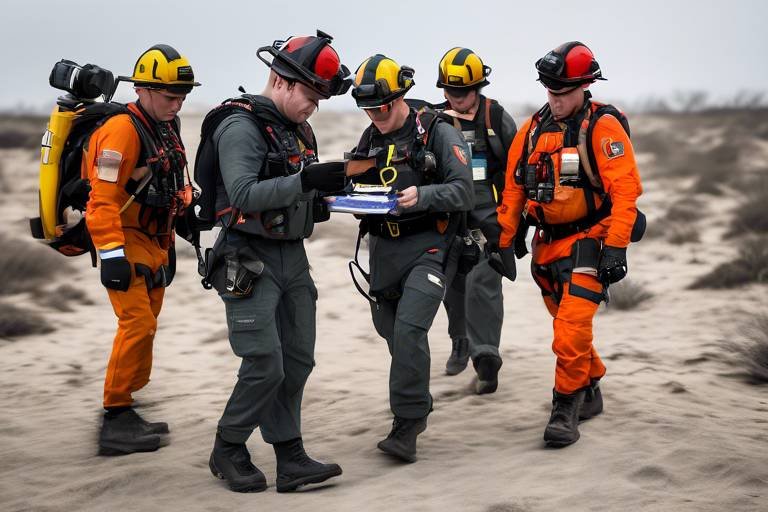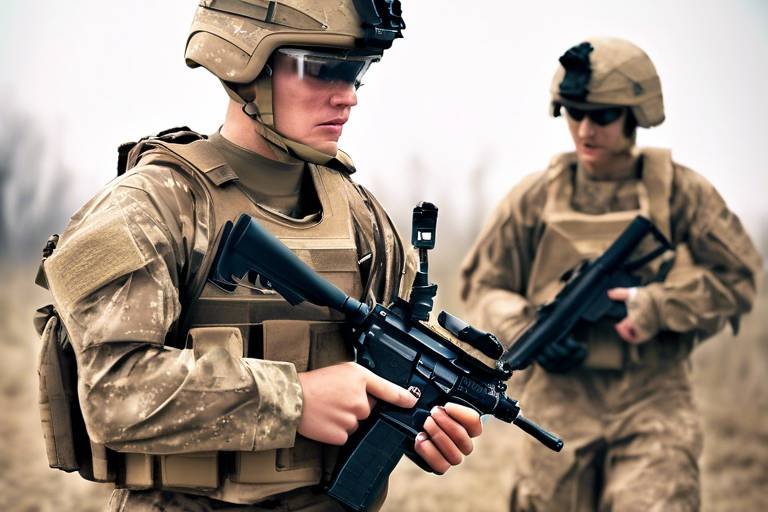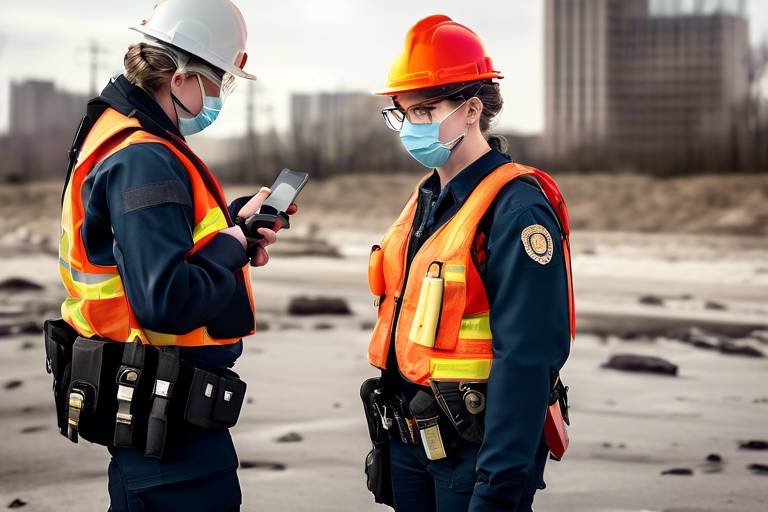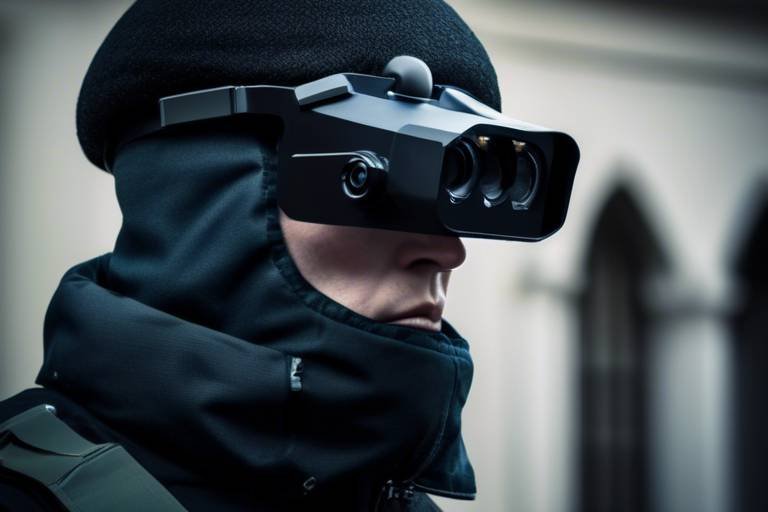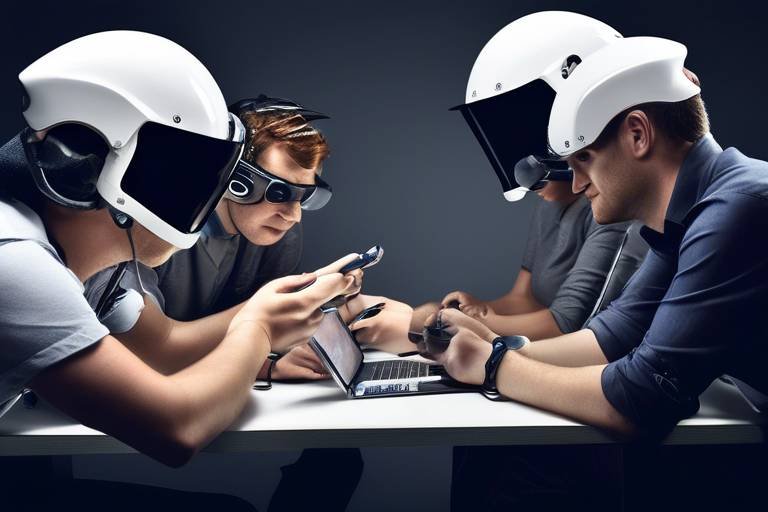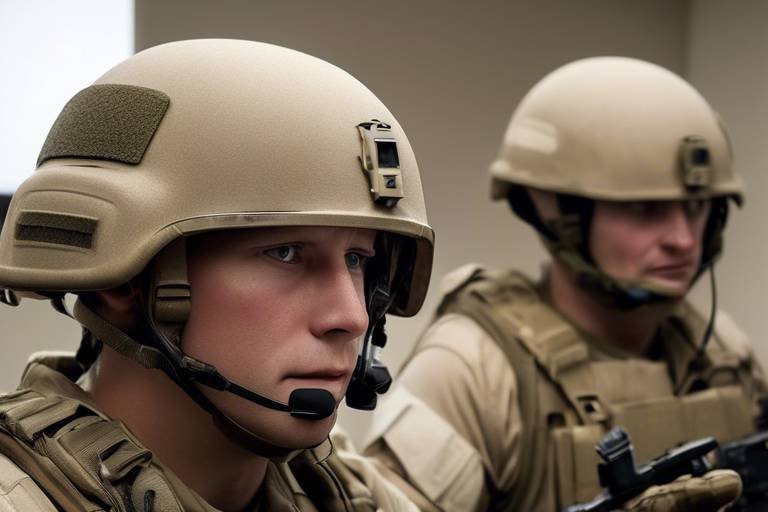Wearable Tech for Monitoring and Managing Combat Readiness
In an era where technology reigns supreme, wearable tech has emerged as a game-changer in the military landscape. Imagine a soldier equipped with devices that not only track their health but also enhance their performance in real-time. This innovation is crucial for ensuring combat readiness, allowing military personnel to remain at the top of their game even in the most challenging environments. By leveraging data collected from these wearables, commanders can make informed decisions that significantly impact operational efficiency and soldier safety.
Wearable technology encompasses a range of devices designed specifically for military applications. These devices provide insights into various factors that affect a soldier's performance, including health metrics, environmental conditions, and even psychological states. As the battlefield becomes increasingly complex, having access to real-time data is invaluable. It’s akin to having a personal coach and a health advisor rolled into one, right on your wrist. The integration of these technologies not only boosts individual soldier readiness but also enhances team dynamics and mission success rates.
One of the most fascinating aspects of wearable tech in the military is its ability to monitor health and performance simultaneously. Health monitoring wearables, for instance, track vital signs such as heart rate, body temperature, and stress levels. This data is critical, as it can preemptively signal health issues that might arise during intense combat situations. Imagine a soldier who is feeling fatigued or stressed; the wearable device can alert medics and commanders, allowing for timely interventions that could save lives. This seamless integration of health data into military medical systems ensures that help is just a heartbeat away.
Moreover, performance tracking devices assess physical metrics like speed, endurance, and fatigue. These insights help soldiers optimize their training regimens, making them more effective in the field. Think of it as having a fitness tracker that not only counts your steps but also tells you how to improve your stamina and strength for the next mission. The result? Soldiers who are better prepared, both physically and mentally, to face the challenges of combat.
But it’s not just about health and performance; environmental monitoring technologies play a significant role in combat readiness as well. These devices assess external conditions such as temperature, humidity, and air quality, which can greatly influence soldier performance. For instance, understanding weather conditions can help military leaders make informed decisions about deployment and mission planning. It’s like having a weather app that not only tells you if it’s going to rain but also how that rain might affect your mission. This knowledge allows soldiers to adapt quickly to changing conditions, ensuring they remain effective regardless of the environment.
In conclusion, the integration of wearable tech in the military landscape is revolutionizing how combat readiness is monitored and managed. By providing real-time data on health, performance, and environmental factors, these devices empower soldiers and commanders alike to make better decisions. As we continue to explore the potential of wearable technology, one thing is clear: the future of military operations is not just about weapons and strategy; it’s also about the smart use of technology to enhance human capability.
- What types of wearable devices are used in the military?
Military wearables include health monitoring devices, performance trackers, and environmental sensors, each designed to enhance soldier readiness. - How do wearable devices improve soldier health?
These devices monitor vital signs and stress levels, allowing for timely medical interventions during combat. - Can wearable technology adapt to environmental changes?
Yes, environmental monitoring technologies help soldiers adjust to changing conditions, ensuring optimal performance in various terrains. - What role does data analysis play in combat readiness?
Data analysis from wearables informs strategic decisions and improves mission planning, enhancing overall operational effectiveness.
Introduction to Wearable Technology in Military
Wearable technology has emerged as a game-changer in the military landscape, revolutionizing the way soldiers monitor their health and performance in real-time. Imagine a soldier on the front lines, equipped not just with weapons, but with advanced technology that tracks their every move, every heartbeat, and every environmental change. This innovative approach not only enhances individual soldier capabilities but also contributes to the overall effectiveness of military operations. In today's fast-paced combat scenarios, having immediate access to critical data can mean the difference between life and death.
These devices are designed to be lightweight and unobtrusive, allowing soldiers to focus on their missions without the distraction of bulky equipment. From smartwatches that monitor vital signs to biometric sensors that provide insights into physical performance, the range of wearable devices available is impressive. Each device plays a crucial role in ensuring that soldiers are always at their best, ready to face any challenge that comes their way.
Moreover, the integration of wearable technology with existing military systems enhances the data collection process. This synergy allows for a comprehensive understanding of a soldier's condition and readiness. For example, a smartwatch might not only track heart rate but also communicate with a central system that alerts commanders about a soldier's health status. This level of connectivity ensures that decisions can be made swiftly, based on real-time data, ultimately improving operational efficiency.
As we delve deeper into the world of wearable technology in the military, it's essential to recognize its potential to transform not just individual performance but also the broader strategic landscape. By harnessing the power of data, military leaders can make informed decisions that enhance combat readiness and ensure the safety of their troops. In the following sections, we will explore the various types of wearable devices, their functions, and the significant impact they have on modern military operations.
Types of Wearable Devices
In the evolving landscape of military technology, wearable devices have emerged as game-changers, transforming how soldiers monitor their health and performance in the field. These devices come in various forms, each tailored to meet the unique demands of military operations. From smartwatches to biometric sensors, the diversity of wearable tech is designed to enhance combat readiness by providing real-time data that can be crucial during missions.
One of the most prevalent types of wearable devices is the smartwatch. These multifunctional gadgets do more than just tell time; they can track health metrics, receive notifications, and even provide navigation assistance. In combat situations, a soldier can glance at their smartwatch to quickly assess their heart rate, monitor their physical state, and stay connected with their unit without fumbling with bulky equipment.
Another critical category is fitness trackers. These devices focus primarily on monitoring physical activity and performance metrics. They can measure steps taken, distance covered, and calories burned, helping soldiers maintain their physical readiness. With features like GPS tracking, fitness trackers can also provide insights into a soldier's endurance and performance over time, allowing for tailored training regimens.
Moreover, biometric sensors are gaining traction in military applications. These sensors can be integrated into clothing or worn as patches and are designed to monitor vital signs such as heart rate variability, body temperature, and even hydration levels. By continuously tracking these metrics, biometric sensors can alert soldiers to potential health risks before they escalate, thereby preventing serious injuries or health issues during critical operations.
To illustrate the variety and functionalities of these devices, consider the following
| Device Type | Key Features | Benefits |
|---|---|---|
| Smartwatch | Health tracking, notifications, navigation | Quick data access, communication, multitasking |
| Fitness Tracker | Activity monitoring, GPS, performance metrics | Enhanced physical readiness, tailored training |
| Biometric Sensor | Vital signs monitoring, integration with medical systems | Proactive health management, injury prevention |
These wearables not only serve individual soldiers but also contribute to the larger operational framework. For instance, the data collected by these devices can be aggregated and analyzed to provide commanders with a comprehensive overview of troop health and readiness. This information is invaluable for making informed decisions about deployments and mission planning.
In summary, the types of wearable devices available for military use are as diverse as the challenges faced by soldiers in combat. By leveraging the unique features of smartwatches, fitness trackers, and biometric sensors, the military can enhance combat readiness, improve soldier safety, and ultimately ensure mission success.
- What are the main benefits of using wearable technology in the military?
Wearable technology enhances health monitoring, performance tracking, and environmental awareness, contributing to overall combat readiness. - How do wearable devices integrate with existing military systems?
Many wearable devices can sync with military medical systems, allowing for real-time health data access and analysis. - Can wearable technology predict health issues before they arise?
Yes, devices equipped with biometric sensors can monitor vital signs continuously, alerting soldiers and medics to potential health risks.
Health Monitoring Wearables
In the fast-paced world of military operations, have emerged as essential tools that significantly enhance combat readiness. These devices are not just fancy gadgets; they are lifelines that track vital signs such as heart rate, body temperature, and stress levels. Imagine being able to monitor a soldier's health in real-time, detecting potential issues before they escalate into serious problems. This capability is crucial during intense combat situations where every second counts.
These wearables provide a wealth of data that can be analyzed to inform decisions on the battlefield. For instance, a soldier experiencing elevated heart rates or abnormal temperature fluctuations can be quickly identified, allowing commanders to take appropriate actions. This proactive approach not only safeguards the health of individual soldiers but also enhances the overall effectiveness of the unit. After all, a healthy soldier is a ready soldier.
Moreover, the integration of these devices with military medical systems is a game changer. When a soldier's health data is seamlessly shared with medical personnel, it ensures that immediate interventions can take place. This integration allows for a more coordinated response to health crises, enabling medics to access critical information at a moment's notice. Imagine a scenario where a soldier collapses due to heat exhaustion; with real-time data, medics can swiftly assess the situation and provide the necessary care without delay.
Another remarkable feature of health monitoring wearables is their ability to send real-time alerts and notifications. These alerts can inform commanders and medical staff of any potential health risks, allowing for immediate action. For example, if a soldier's stress levels spike dangerously high, an alert can be triggered, prompting a tactical reassessment of the situation or a quick check-in with the individual. Such responsiveness can mean the difference between life and death in critical moments.
To illustrate the impact of health monitoring wearables, consider the following table that outlines some of the key features and benefits:
| Feature | Benefit |
|---|---|
| Real-time Vital Sign Monitoring | Immediate identification of potential health issues |
| Integration with Medical Systems | Streamlined access to health data for timely interventions |
| Real-time Alerts | Proactive response to health risks, enhancing soldier safety |
| Data Analytics | Informed decision-making for optimal mission planning |
In conclusion, health monitoring wearables are revolutionizing the way military personnel manage their health and readiness. By providing critical data and facilitating swift responses to health concerns, these devices not only protect soldiers but also enhance the effectiveness of military operations. As technology continues to evolve, we can expect even more innovative solutions that will further improve combat readiness and soldier welfare.
Integration with Medical Systems
In the fast-paced and often unpredictable environment of military operations, the integration of wearable technology with medical systems is nothing short of revolutionary. Imagine a scenario where a soldier is engaged in a high-stress mission, and their wearable device continuously monitors vital signs such as heart rate, oxygen levels, and even stress indicators. This real-time data is not just for the soldier's awareness; it is seamlessly transmitted to military medical systems, ensuring that health professionals have immediate access to critical information.
This integration allows for a proactive approach to soldier health and safety. For instance, if a wearable device detects an abnormal heart rate or a significant rise in stress levels, it can automatically alert medical personnel. This instant communication can be the difference between life and death in combat situations. The ability to monitor and respond to health issues in real-time is akin to having a guardian angel on the battlefield, always watching over the troops.
Moreover, the data collected from these wearables can be stored and analyzed within military medical systems, creating a comprehensive health profile for each soldier. This profile can include historical data on injuries, recovery times, and overall health trends. By understanding these patterns, medical teams can tailor their interventions and support to meet the specific needs of each soldier, optimizing their readiness for combat.
Additionally, the integration of wearables with medical systems fosters a culture of collaboration and communication among military personnel and healthcare providers. When soldiers know that their health is being monitored and prioritized, it can enhance their morale and confidence in the system. They can focus on their missions, knowing that if something goes wrong, help is just a heartbeat away.
In summary, the integration of wearable technology with military medical systems is a game-changer. It not only enhances the ability to monitor soldiers' health but also ensures timely interventions that can significantly improve outcomes. As technology continues to evolve, the potential for even more sophisticated integrations promises a future where soldiers can operate with enhanced safety and efficiency.
- What types of data do wearable devices collect? Wearable devices typically collect data on vital signs, physical performance metrics, and environmental conditions.
- How does real-time monitoring improve soldier safety? Real-time monitoring allows for immediate alerts and interventions if a soldier's health is at risk, enabling quick medical response.
- Can wearable technology be used in all types of military operations? Yes, wearable technology is designed to be versatile and can be adapted for various military environments and missions.
- What is the future of wearable tech in the military? The future includes advancements in integration, predictive analytics, and enhanced data collection capabilities to further improve soldier readiness and safety.
Real-time Alerts and Notifications
In the fast-paced world of military operations, every second counts. Imagine a soldier in the field, battling not only the enemy but also the challenges posed by their own physical condition. This is where from wearable technology come into play. These devices are designed to monitor various health parameters continuously, sending instant alerts to both the soldier and their commanding officers if any anomalies are detected. For instance, if a soldier's heart rate spikes dangerously high or their body temperature exceeds safe limits, the wearable device will immediately notify the relevant personnel, allowing them to take swift action.
These alerts are not just simple notifications; they can be customized based on the specific needs of the unit or individual soldier. For example, a soldier with a known heart condition might have their alert settings adjusted to trigger at lower thresholds than their peers. This personalized approach ensures that every soldier receives the attention they need, tailored to their unique health profiles.
Furthermore, the integration of these alerts with command systems enhances overall situational awareness. Commanders can receive consolidated health data from multiple soldiers in real-time, allowing them to make informed decisions about troop deployment and resource allocation. This capability is especially critical during high-stress situations where quick decision-making is essential for mission success.
To illustrate the impact of real-time alerts, consider the following table that highlights key features and benefits of these notifications:
| Feature | Benefit |
|---|---|
| Instant Notifications | Immediate awareness of health issues, enabling prompt interventions. |
| Customizable Alerts | Personalized settings based on individual health needs and risks. |
| Integration with Command Systems | Enhanced situational awareness for commanders, aiding in strategic decision-making. |
| Real-time Data Sharing | Continuous monitoring and data sharing improve overall troop safety. |
In conclusion, the power of real-time alerts and notifications cannot be overstated. They serve as a lifeline for soldiers in the field, ensuring that health risks are addressed proactively rather than reactively. This technology not only enhances individual soldier safety but also contributes to the overall effectiveness and readiness of military units. The ability to make informed decisions based on real-time data is a game-changer in modern warfare, ensuring that soldiers are always at their best when it matters most.
- What types of health metrics can wearable devices monitor? Wearable devices can track a variety of metrics, including heart rate, body temperature, stress levels, and even sleep patterns.
- How do real-time alerts improve soldier safety? Real-time alerts provide immediate notifications of potential health issues, allowing for quick interventions that can prevent serious complications.
- Can wearable devices integrate with existing military systems? Yes, many wearable devices are designed to seamlessly integrate with military medical systems, enhancing data accessibility and management.
- What are the benefits of customizable alerts? Customizable alerts ensure that soldiers receive notifications tailored to their specific health needs, increasing the likelihood of timely interventions.
Performance Tracking Devices
When it comes to the battlefield, every second counts, and being in peak physical condition can make a world of difference. That's where come into play. These innovative gadgets are designed to assess a soldier's physical metrics such as speed, endurance, and fatigue levels. Imagine having a personal coach that fits snugly on your wrist, constantly monitoring your performance and providing insights that can help you push your limits. With these devices, soldiers can optimize their training regimens, ensuring they are always ready for combat situations.
Performance tracking devices work by collecting data on various physical activities. For instance, they can measure how quickly a soldier can run a certain distance, how many push-ups they can do in a minute, or even how long it takes to recover after intense exertion. This data is invaluable not only for individual soldiers but also for military leaders who need to assess the readiness of their units. By analyzing these metrics, commanders can identify which soldiers may need additional training or support, ensuring that everyone is operating at their best.
Moreover, these devices often come equipped with advanced features such as GPS tracking and heart rate monitoring. This dual functionality allows soldiers to not only track their physical output but also monitor their physiological responses to stress and exertion. For example, if a soldier's heart rate spikes unexpectedly during a routine training exercise, it could indicate that they are pushing themselves too hard or that they are at risk of injury. In such cases, the device can alert the soldier to slow down or take a break, potentially preventing serious health issues.
In addition to individual performance tracking, these devices can also facilitate team dynamics. By sharing performance data among team members, soldiers can encourage each other to improve and hold one another accountable. This fosters a sense of camaraderie and collective responsibility, which is crucial in high-stakes environments like military operations. Imagine a squad where each member is aware of their own strengths and weaknesses, as well as those of their teammates; this knowledge can lead to better strategic planning and execution during missions.
To illustrate the impact of performance tracking devices, consider the following table that outlines some of the key metrics these devices can measure:
| Metric | Description |
|---|---|
| Speed | Measures how fast a soldier can run over a set distance. |
| Endurance | Assesses how long a soldier can maintain a physical activity without fatigue. |
| Heart Rate | Monitors the soldier's heart rate during exercises to assess cardiovascular fitness. |
| Recovery Time | Tracks how quickly a soldier's heart rate returns to normal after exertion. |
In conclusion, performance tracking devices are not just gadgets; they are essential tools that enhance a soldier's ability to prepare for and respond to the demands of combat. By leveraging real-time data, these devices help optimize training, improve physical readiness, and ultimately contribute to mission success. As technology continues to evolve, we can expect even more sophisticated solutions that will further empower our armed forces to meet the challenges of modern warfare.
- What types of performance metrics can these devices track? Performance tracking devices can monitor speed, endurance, heart rate, recovery time, and more.
- How do performance tracking devices help in training? They provide real-time feedback, allowing soldiers to adjust their training based on their performance data.
- Can these devices be used in all environments? Yes, many performance tracking devices are designed to be durable and functional in various terrains and weather conditions.
Environmental Monitoring Technologies
In the ever-evolving landscape of military operations, have emerged as a game-changer. These advanced systems are designed to assess various external conditions that could impact soldier performance and safety during missions. Imagine being in the middle of a combat zone where the weather can shift from calm to chaotic in a matter of minutes. This is where wearable tech steps in, providing real-time insights that can make all the difference. By monitoring factors such as temperature, humidity, and air quality, these devices help ensure that soldiers are not only prepared but also able to adapt to changing conditions on the fly.
One of the most significant advantages of these technologies is their ability to provide contextual data that informs decision-making. For instance, if a soldier is operating in a high-temperature environment, the wearable device can alert them to potential heat stress, allowing them to take preventative measures before it becomes a critical issue. This proactive approach can be the difference between mission success and failure, as it directly correlates to soldier readiness and safety.
Moreover, understanding environmental factors can significantly influence strategic decisions made by military leaders. For example, if data indicates that air quality is deteriorating in a specific area, commanders can reassess the viability of a mission or adjust their tactics accordingly. This level of insight is crucial, especially in operations where every second counts and the stakes are incredibly high.
To illustrate the impact of environmental monitoring technologies, consider the following table that highlights key environmental factors and their implications for combat readiness:
| Environmental Factor | Impact on Soldiers | Recommended Action |
|---|---|---|
| Temperature | Risk of heat stress or hypothermia | Adjust gear or seek shelter |
| Humidity | Impact on hydration levels | Increase fluid intake |
| Air Quality | Respiratory issues | Use protective masks |
As soldiers navigate diverse terrains, the ability to monitor and respond to environmental challenges becomes crucial. Wearable technology not only enhances their situational awareness but also boosts their resilience. For example, if a soldier is operating in a jungle environment where humidity is high, their wearable device can provide alerts about hydration levels, encouraging them to drink water regularly. This real-time feedback loop ensures that soldiers are always performing at their best, regardless of external conditions.
In conclusion, the integration of environmental monitoring technologies into military operations is not just a trend; it's a necessity. With the capacity to gather and analyze crucial data, these devices empower soldiers to make informed decisions, adapt to their surroundings, and ultimately enhance their combat readiness. As technology continues to advance, we can only expect these tools to become even more sophisticated, further revolutionizing the way military operations are conducted.
- What types of environmental factors can wearable technology monitor?
Wearable technology can monitor a range of environmental factors including temperature, humidity, air quality, and even UV exposure, providing soldiers with critical data during missions. - How does environmental monitoring improve soldier safety?
By providing real-time data on environmental conditions, soldiers can take proactive measures to mitigate risks, such as heat stress or exposure to harmful air quality. - Can these technologies be integrated with existing military systems?
Yes, many environmental monitoring wearables can seamlessly integrate with military systems, allowing for enhanced data sharing and decision-making.
Impact of Weather on Combat Readiness
The weather can be a soldier's best friend or worst enemy. Imagine gearing up for a mission, adrenaline pumping, ready to face whatever comes your way, only to be met with unexpected rain, snow, or extreme heat. These elements can drastically affect not only the performance of soldiers but also the overall success of military operations. Understanding the impact of weather on combat readiness is crucial for military leaders to make informed decisions and ensure the safety and effectiveness of their troops.
Weather conditions can influence various factors in combat scenarios, including visibility, mobility, and even morale. For instance, heavy rain can reduce visibility and make terrains slippery, hampering movement. On the other hand, extreme heat can lead to dehydration and heat exhaustion, putting soldiers at risk. In cold weather, frostbite and hypothermia become serious threats. Therefore, it is essential for military personnel to be equipped with real-time data regarding weather changes to adapt their strategies accordingly.
Wearable technology plays a significant role in this adaptation. With devices that monitor environmental conditions, soldiers can receive alerts about sudden weather changes. This capability allows them to adjust their gear, hydration levels, and even tactical plans on the fly. In essence, the integration of wearable tech into military operations not only enhances individual soldier performance but also contributes to the larger mission objectives.
To further illustrate the impact of weather on combat readiness, consider the following table that outlines different weather conditions and their potential effects on military operations:
| Weather Condition | Potential Effects |
|---|---|
| Heavy Rain | Reduced visibility, slippery terrain, increased risk of equipment failure |
| Extreme Heat | Dehydration, heat exhaustion, decreased physical performance |
| Snow and Ice | Frostbite, hypothermia, mobility challenges |
| High Winds | Impact on aerial operations, noise disruption, equipment stability issues |
By leveraging data from wearable devices, military leaders can not only monitor the physical well-being of their troops but also assess how weather conditions might affect mission success. This proactive approach allows for better planning and resource allocation, ensuring that soldiers are prepared for whatever Mother Nature throws their way. In this fast-paced, unpredictable environment, the ability to adapt quickly to changing weather conditions can mean the difference between success and failure on the battlefield.
- How does weather affect soldier performance? Weather can impact visibility, mobility, and overall health, leading to decreased performance in combat situations.
- What role does wearable technology play in monitoring weather conditions? Wearable tech provides real-time data on environmental conditions, allowing soldiers to adapt their strategies and gear accordingly.
- Can wearable devices predict weather changes? While they may not predict weather changes, they can provide alerts based on current environmental data, helping soldiers prepare for sudden shifts.
- Why is it important to understand weather conditions before a mission? Understanding weather conditions is crucial for planning effective strategies, ensuring soldier safety, and optimizing mission success.
Adapting to Environmental Challenges
In the ever-evolving landscape of military operations, is not just an option; it’s a necessity. Soldiers are often deployed in diverse terrains, from arid deserts to frigid mountains, and each environment presents its own unique set of challenges. Wearable technology plays a pivotal role in helping soldiers navigate these challenges effectively. Imagine a soldier equipped with a device that not only tracks their physical metrics but also provides real-time data about the surrounding environment. This capability can be the difference between success and failure in high-stakes situations.
Wearable devices equipped with environmental sensors can monitor critical factors such as temperature, humidity, and air quality. For instance, if a soldier is operating in a humid jungle, the device can alert them to rising temperatures that could lead to heat stress. This immediate feedback allows soldiers to take proactive measures, such as hydrating or adjusting their gear, ensuring they remain in peak condition. The integration of these technologies creates a safety net, allowing for rapid responses to environmental changes that could otherwise compromise a mission.
Furthermore, these wearables can facilitate communication between soldiers and command. By relaying environmental data back to command centers, military leaders can make informed decisions about troop movements and mission planning. For example, if a battalion is preparing to advance into a storm-affected area, the command can assess the data from soldiers’ wearables to determine the best course of action. This level of situational awareness is invaluable in maintaining operational effectiveness.
To illustrate, consider the following table that outlines how specific environmental factors can impact soldier performance and the corresponding adaptations made possible through wearable technology:
| Environmental Factor | Impact on Soldier Performance | Wearable Tech Adaptation |
|---|---|---|
| High Temperature | Increased risk of heat exhaustion | Real-time heat index alerts |
| Low Air Quality | Decreased stamina and focus | Air quality monitoring with notifications |
| Variable Terrain | Increased fatigue and risk of injury | Performance tracking for optimal pacing |
In summary, the ability to adapt to environmental challenges is significantly enhanced through the use of wearable technology. These devices not only provide critical data but also foster a culture of proactive engagement with the environment. As soldiers become more attuned to the conditions around them, they can make better decisions, ensuring both their safety and the success of their missions. The future of military operations lies in the seamless integration of technology and human capability, creating a force that is not just reactive but also resilient and adaptable.
- What types of environmental factors can wearable tech monitor?
Wearable technology can monitor a variety of environmental factors including temperature, humidity, air quality, and even terrain conditions.
- How does wearable tech improve soldier safety?
By providing real-time data and alerts about environmental conditions, wearable tech helps soldiers make informed decisions to mitigate risks and enhance their safety during missions.
- Can wearable devices communicate with command centers?
Yes, many wearable devices are designed to relay environmental data back to command centers, enabling military leaders to make strategic decisions based on real-time information.
Data Analysis and Decision-Making
In today's fast-paced military environment, the ability to leverage data analysis for informed decision-making is more critical than ever. Wearable technology plays a pivotal role in this arena, as it collects vast amounts of data from soldiers in real-time. This data, when analyzed, can provide invaluable insights that enhance operational efficiency and soldier safety. Imagine being able to predict potential health issues or performance declines before they occur—this is the power of data-driven decision-making.
The information gathered from wearable devices can be categorized into several key areas, including health metrics, performance statistics, and environmental conditions. Each of these categories contributes to a comprehensive understanding of a soldier's readiness and capability. For instance, health metrics can reveal if a soldier is at risk of dehydration or fatigue, while performance statistics can highlight areas for improvement in physical training. Environmental data can indicate whether conditions are suitable for deployment.
One of the most exciting aspects of this data is the potential for predictive analytics. By utilizing historical data and advanced algorithms, military leaders can forecast potential challenges that may arise during missions. For example, if data shows a trend of increased fatigue levels in certain weather conditions, commanders can proactively adjust training schedules or mission plans to mitigate risks. This predictive capability transforms the way military operations are planned and executed, making them more adaptive and resilient.
Furthermore, establishing feedback loops from the data collected by wearable technology fosters a culture of continuous improvement. This means that as soldiers use these devices, their performance and health data are continuously analyzed, and insights are fed back into training programs and operational strategies. For example, if a specific training regimen is found to correlate with improved performance metrics, it can be adopted more broadly across units. This iterative process not only enhances individual soldier readiness but also elevates the overall effectiveness of military operations.
To illustrate the impact of data analysis on decision-making, consider the following table that summarizes how different types of data contribute to various operational decisions:
| Data Type | Insights Gained | Operational Decisions |
|---|---|---|
| Health Metrics | Identify health risks (e.g., dehydration, fatigue) | Adjust training schedules, deploy medical support |
| Performance Statistics | Evaluate physical readiness and endurance | Modify training programs, enhance soldier capabilities |
| Environmental Conditions | Assess suitability for deployment | Plan missions according to weather forecasts |
In conclusion, the integration of wearable technology into military operations is revolutionizing the way data is analyzed and utilized for decision-making. By tapping into the wealth of information provided by these devices, military leaders can make more informed, timely decisions that enhance combat readiness and ensure the safety and effectiveness of their personnel. As technology continues to evolve, the potential for even greater advancements in data analysis and decision-making is limitless, paving the way for a new era in military operations.
- What types of data do wearable devices collect in the military? Wearable devices collect health metrics, performance statistics, and environmental conditions data.
- How does predictive analytics improve military operations? Predictive analytics help forecast potential challenges, allowing for proactive adjustments to training and mission planning.
- What are feedback loops in the context of wearable tech? Feedback loops involve continuously analyzing data from wearable devices to improve training protocols and operational strategies.
- Can wearable technology prevent health issues in soldiers? Yes, by monitoring vital signs and providing real-time alerts, wearable technology can help prevent health issues during combat.
Predictive Analytics in Combat Readiness
Predictive analytics is revolutionizing the way military leaders approach combat readiness. By leveraging historical data and advanced algorithms, military strategists can anticipate potential challenges before they arise. Imagine having the ability to foresee issues related to soldier performance, equipment readiness, and even environmental factors that could impact a mission. This proactive approach not only enhances decision-making but also significantly reduces risks associated with unforeseen circumstances.
One of the key components of predictive analytics is its ability to analyze vast amounts of data collected from various sources, including wearable technology. For instance, data from health monitoring wearables can provide insights into a soldier's physical condition over time. By identifying patterns, such as increased fatigue or declining heart rates, commanders can make informed decisions about troop deployment, training adjustments, and even medical interventions.
Moreover, predictive analytics can be applied to equipment and logistics. By analyzing usage patterns and maintenance records, military units can predict when equipment is likely to fail or require servicing. This foresight allows for timely maintenance, ensuring that all gear is operational when it matters most. In essence, it’s like having a crystal ball that helps military leaders stay one step ahead of challenges, enhancing overall operational efficiency.
To illustrate the impact of predictive analytics, consider the following table that summarizes how different data points contribute to combat readiness:
| Data Point | Impact on Readiness |
|---|---|
| Health Metrics | Identifies fatigue and stress levels, allowing for timely rest or medical intervention. |
| Weather Conditions | Forecasts environmental challenges, aiding in mission planning and resource allocation. |
| Equipment Usage | Predicts maintenance needs, ensuring that all gear is ready for deployment. |
| Training Data | Enhances training protocols by identifying areas for improvement based on performance trends. |
The integration of predictive analytics into military operations fosters a culture of continuous improvement. By establishing feedback loops where data is constantly analyzed and utilized, military units can refine their strategies and enhance their readiness over time. This ongoing process not only optimizes current operations but also prepares soldiers and commanders for future challenges, ensuring they remain agile and effective in an ever-changing battlefield landscape.
- What is predictive analytics in the military context?
Predictive analytics in the military involves using historical data and algorithms to forecast potential challenges related to combat readiness, enabling proactive decision-making. - How do wearable devices contribute to predictive analytics?
Wearable devices collect real-time health and performance data from soldiers, which can be analyzed to identify trends and predict issues before they become critical. - Can predictive analytics improve equipment readiness?
Yes, by analyzing equipment usage data, predictive analytics can forecast when maintenance is needed, ensuring that all gear is operational when required. - What are the benefits of using predictive analytics in military operations?
The benefits include enhanced decision-making, reduced risks, improved operational efficiency, and a culture of continuous improvement within military units.
Feedback Loops for Continuous Improvement
The concept of feedback loops is pivotal in the realm of military operations, particularly when it comes to enhancing combat readiness through wearable technology. Imagine a scenario where soldiers are not just equipped with smart devices, but these devices are actively communicating data back to commanders and training coordinators. This dynamic interaction creates a continuous cycle of assessment and enhancement, akin to a well-oiled machine that thrives on constant input and adjustment.
When soldiers wear devices that monitor their health and performance, the data collected can be analyzed to identify trends and areas for improvement. For instance, if a significant number of soldiers report increased fatigue during specific training exercises, military leaders can adjust training protocols to address these issues. This proactive approach not only boosts the soldiers' efficiency but also ensures that they are prepared for the rigors of combat.
Moreover, the integration of real-time data analysis allows for immediate feedback. For example, if a soldier's heart rate spikes beyond a safe threshold during a mission, the wearable tech can alert both the individual and their commanding officer. This kind of immediate feedback is crucial; it can mean the difference between life and death in high-stakes situations. Commanders can then make informed decisions, perhaps pulling a soldier from the field for medical evaluation or adjusting operational plans based on the health metrics of their troops.
To further illustrate this process, consider the following table that outlines how feedback loops function within military training and operations:
| Step | Description |
|---|---|
| 1. Data Collection | Wearable devices gather data on soldier health and performance during training and missions. |
| 2. Data Analysis | Commanders and analysts review the data to identify patterns and areas needing improvement. |
| 3. Implementation of Changes | Adjustments to training protocols or operational strategies are made based on the analysis. |
| 4. Continuous Monitoring | The cycle repeats with ongoing data collection to assess the effectiveness of the changes. |
This feedback loop not only fosters a culture of continuous improvement but also empowers soldiers by making them active participants in their development. They can see firsthand how their performance metrics influence decisions and protocols, which can be incredibly motivating. It’s like being part of a sports team where every player knows their stats and works together to improve as a unit.
In conclusion, feedback loops driven by wearable technology are revolutionizing military readiness. By leveraging real-time data and promoting a culture of improvement, military leaders can ensure that their troops are not only prepared for combat but are also constantly evolving to meet new challenges. This approach not only enhances individual soldier performance but also strengthens the overall effectiveness of military operations.
- What types of data do wearable devices collect in the military?
Wearable devices collect various types of data, including vital signs such as heart rate, body temperature, stress levels, and performance metrics like speed and endurance.
- How do feedback loops improve military training?
Feedback loops allow for continuous assessment and adjustment of training protocols based on real-time data, ensuring that soldiers are always prepared for combat conditions.
- Can wearable technology predict health issues?
Yes, by analyzing trends in health data, wearable technology can help predict potential health issues, allowing for timely interventions.
- How does environmental monitoring integrate with wearable tech?
Environmental monitoring provides data on external conditions, which can be combined with personal health data to assess overall soldier readiness and safety during missions.
Frequently Asked Questions
- What types of wearable technology are used in the military?
Wearable technology in the military includes a variety of devices such as smartwatches, fitness trackers, and biometric sensors. Each of these devices serves a specific purpose, from tracking vital health metrics to monitoring performance and environmental conditions, ultimately enhancing combat readiness.
- How do health monitoring wearables benefit soldiers?
Health monitoring wearables track crucial vital signs like heart rate, body temperature, and stress levels. By providing real-time data, these devices can help prevent health issues during combat, allowing for timely medical interventions and ensuring soldiers' safety on the battlefield.
- Can wearable devices integrate with military medical systems?
Absolutely! Many wearable devices are designed to seamlessly integrate with military medical systems. This integration enables quick access to health data, facilitating immediate medical responses when necessary, which is critical for maintaining soldier health during missions.
- What role does environmental monitoring play in combat readiness?
Environmental monitoring technologies assess factors such as temperature, humidity, and air quality. Understanding these conditions allows military leaders to make informed decisions about deployments and mission planning, ensuring that soldiers are prepared for various environmental challenges.
- How does data analysis improve military decision-making?
The data collected from wearable devices can be analyzed to inform strategic decisions. By utilizing predictive analytics, military leaders can forecast potential challenges and proactively address issues related to soldier readiness, ultimately improving mission planning and execution.
- What is the significance of feedback loops in wearable tech?
Establishing feedback loops from wearable tech data fosters a culture of continuous improvement within military operations. By analyzing the data collected, military units can enhance training protocols and operational effectiveness over time, adapting to new challenges as they arise.





